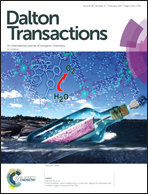Optical properties of trinuclear metal chalcogenolate complexes – room temperature NIR fluorescence in [Cu2Ti(SPh)6(PPh3)2]†
Abstract
The optical properties of four isostructural trinuclear chalcogenolato bridged metal complexes [Cu2Sn(SPh)6(PPh3)2], [Cu2Sn(SePh)6(PPh3)2], [Ag2Sn(SPh)6(PPh3)2] and [Cu2Ti(SPh)6(PPh3)2] have been investigated by absorption and photoluminescence spectroscopy and time-dependent density functional theory (TDDFT) calculations. All copper–tin compounds demonstrate near-infrared (NIR) phosphorescence at ∼900–1100 nm in the solid state at low temperature, which is nearly absent at ambient temperature. Stokes shifts of these emissions are found to be unusually large with values of about 1.5 eV. The copper–titanium complex [Cu2Ti(SPh)6(PPh3)2] also shows luminescence in the NIR at 1090 nm but with a much faster decay (τ ∼ 10 ns at 150 K) and a much smaller Stokes shift (ca. 0.3 eV). Even at 295 K this fluorescence is found to comprise a quantum yield as high as 9.5%. The experimental electronic absorption spectra well correspond to the spectra simulated from the calculated singlet transitions. In line with the large Stokes shifts of the emission spectra the calculations reveal for the copper–tin complexes strong structural relaxation of the excited triplet states whereas those effects are found to be much smaller in the case of the copper–titanium complex.
![Graphical abstract: Optical properties of trinuclear metal chalcogenolate complexes – room temperature NIR fluorescence in [Cu2Ti(SPh)6(PPh3)2]](/en/Image/Get?imageInfo.ImageType=GA&imageInfo.ImageIdentifier.ManuscriptID=C6DT04287B&imageInfo.ImageIdentifier.Year=2017)


 Please wait while we load your content...
Please wait while we load your content...